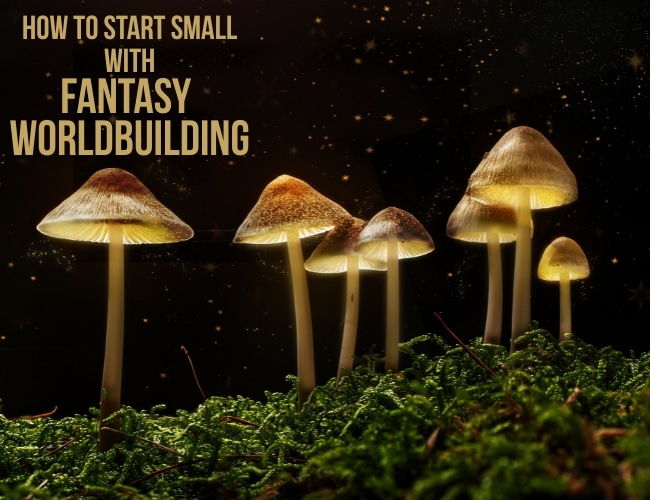Many fantasy writers love worldbuilding—sketching out maps, cataloguing pantheons, and crafting magic systems. But when it’s time to write a story set in that world, they often struggle to translate their fantasy world building lore into narrative.

Today's article is written by Kahina Necaise. Kahina is the executive editor at Fabled Planet, a provider of specialist services and resources for writers of fantasy and science fiction. Welcome, Kahina!
In my work as a developmental editor of the science fiction and fantasy genres, I see this all the time. Some writers over-describe their settings, throwing as much of their creation at readers as possible and hoping something sticks. The result is often flat exposition and description that would feel more at home in an encyclopedia than a novel. Others are overwhelmed and don’t know where to start, which keeps them from getting a first draft out at all.
Both kinds of writers face the same core problem: they don't know how to make a world come to life on the page. This is understandable. After all, how do you fit an entire world into a book—and tell a compelling story at the same time?
The answer, paradoxically, is to start small.
Don’t believe it? Try it yourself with the quick, concrete steps below.
How to Start Small with Fantasy Worldbuilding
1. Anchor with a familiar detail.
Anchor readers into your fantasy world with a familiar detail that echoes similar settings in our world. This gives them something concrete to visualize and serves as a doorway into your unique world. It kickstarts the imagination without overwhelming it.
Let’s look at how this could work in both description and exposition, the two main ways a writer builds a world within a story. The examples for each step of each category will build on each other to form a short paragraph.
Description example:
From dilapidated window frames, laundry lines heavy with threadbare sheets crisscrossed over the filthy, narrow streets.
Exposition example:
Magic was inherited, like height or eye color.
These opening images are common and easy to grasp, even for readers who know nothing about the worlds they describe.
2. Surprise with an unexpected detail.
Surprise readers with a detail that would be unexpected/paradoxical for the setting in our world but makes sense for your fantasy world.
Description example:
Several sheets had been painted with advanced protective runes—half-faded, but Lor’s trained eyes picked out where they still pulsed faintly in the sun.
Exposition example:
But no one received it unless three members of their own house gave up their potential, so that one relative might wield power instead.
These follow-up details twist the expectations set up earlier. Most readers won’t expect the poor to possess advanced forms of magic. And the idea of a trait being inherited through sacrifice, rather than genetics, adds an unfamiliar but internally consistent logic.
3. Introduce one world-specific term.
Introduce one world-specific term. This could be a word in a different language, an in-world slang phrase, a proper noun, or a common word used in a way unique to your world. Hint at the term’s meaning through context clues.
The goals here are to (1) limit the number of unfamiliar terms you introduce at once and (2) get readers engaging with your world by leaving clues for them to work with.
Reading too many unfamiliar terms without context clues is a passive experience. All readers can do is sit with the gibberish until the author eventually explains it. Ideally, your readers will never be in that state. They’ll always be assembling clues, immersed in your world.
Description example:
Flying overhead, she spotted the slum’s bolder children playing talver on the rooftops, just out of sight of the anti-mage guards making their rounds through the city.
Exposition example:
Those blessed by such sacrifice were named lamshash—destined for greatness, but forbidden all contact with the house that bore them.
These final sentences introduce a bit of flavor with world-specific terms: a game called talver and a class of privileged people called lamshash. Note that neither term is explicitly defined. Instead, you get just enough context to understand them. Talver is a game, and one that’s likely magical and forbidden (that’s why the children play it out of sight of the anti-mage police). Lamshash are a special class of people, but ones who prosper and suffer for their specialness. Each word adds depth and intrigue without slowing the reader down.
Applying these fantasy worldbuilding steps in your own writing
Naturally, you won’t repeat this exact sequence every time you describe something. That would quickly become repetitive!
Sometimes, you’ll skip a step. For example, the word apothecary is probably familiar enough that it can stand in for Step 1. Readers will likely imagine the shelves of little bottles, the mortar and pestle, and the scent of dried herbs. So you can jump straight into Step 2:
“In the apothecary, Mel’s gaze roamed the shelves. Bottled sunshine. Essence of time misspent. A vial of What If?”
You can also use the steps as a diagnostic tool when revising your description or exposition:
- Does your passage contain too many familiar details that readers can already imagine without help? Try cutting everything but the most vivid or atmospheric ones.
- Does it launch into unfamiliar or fantastical details too soon, without something grounded for readers to latch onto? Insert a familiar detail as a launchpad.
- Does it introduce too many world-specific terms without giving readers a way to infer meaning (e.g., “Lieutenant Klipslok Danurel was seen buying a hiron with three ploc”)? Stick to one new term and give it helpful context.
Worldbuilding is only one part of fantasy writing. Weaving that worldbuilding into an actual story is its own skill—and it takes practice. But when you're feeling stuck, it might help to remember this simple mantra: Anchor. Surprise. Introduce.
What's your favorite example of fantasy worldbuilding? What did that fantasy author do that you found most effective? Let us know in the comments!

This article is by guest author Kahina Necaise. Kahina is the executive editor at Fabled Planet, a provider of specialist services and resources for writers of fantasy and science fiction. Fabled Planet is a brand of Fictive Pursuits, which also runs The History Quill and The Niche Reader.
PRACTICE
Following the steps in the article, set the timer for 15 minutes and write a paragraph describing a fantasy location or other worldbuilding element using only the three types of detail outlined.
Let your imagination run wild–what forms of magic, fictional language, and fantastical elements might be in the daily life of your fictional world? You can use the examples as models.
When you're finished with this worldbuilding process, share your work in the Pro Practice Workshop here (and if you’re not a member yet, you can join here).
Finally, after you share, make sure to give feedback to three of your fellow writers.
Happy writing!
This article is by a guest blogger. Would you like to write for The Write Practice? Check out our guest post guidelines.
Interesting, but what if you’ve got something close enough to reality that readers try to “force” a conventional meaning to them? There were two named characters in my prologue: “William LaPorte,” whose personal story was pretty much finished by the end of the prologue (he might make a cameo later in the story), and “the Magician” (my master villain), an extra-dimensional entity that meets his minions first in dreams. Reader after reader said “tell us more about LaPorte” and then didn’t recognize the Magician the next time he appeared. Even when I have minions intentionally going into “commune” with the Magician, I’ve had readers assume these scenes are only dreams: character insight rather than real interaction.